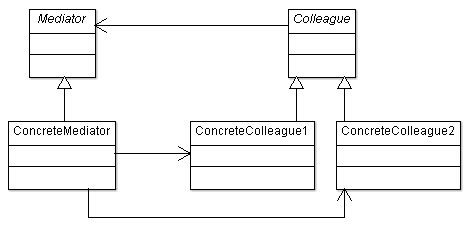> Design Patterns > Mediator Design Pattern
Mediator Design Pattern
Mediator design pattern is used for controlling the interaction between different objects.
Intent
- Define an object that encapsulates how a set of objects interact. Mediator promotes loose coupling by keeping objects from referring to each other explicitly, and it lets you vary their interaction independently.
The intent of mediator design pattern is to have an object to encapsulate the interaction of different objects.
Problem
- There is too much communication between objects, which is increasing the complexity and making it difficult to reuse the objects.
Too much communication between objects increases dependency between them, makes the system complex and reduces the reusability of objects. Also extending the behavior requires more subclasses.
Solution
- Encapsulate the behavior of interaction and coordination in a separate object.
There can be a separate object, which will encapsulate the behavior of interaction of the communicating objects. It will also have responsibility for coordinating the interaction of objects. So objects will communicate through this object only.
Where mediator design pattern is applicable?
- There are set of objects with lot of interaction within them, thus increasing the dependency.
- It's becoming difficult to reuse the objects, because of too much interaction and dependency.
- Behavior has to be customizable without subclassing.
Mediator Design Pattern UML Structure

Participant classes of mediator design pattern
- Mediator class provides interface for interaction between colleague objects.
- ConcreteMediator class implements the method and does the coordination between colleague objects as required for behavior. This has the instance of applicable colleague objects.
- Colleague class provides interface for Colleague objects. It also has the instance of Mediator object.
- ConcreteColleague class implements the method and keeps the instance of respective concrete mediator object.
How they work together?
- Colleague object requests mediator object for interaction with any other colleague object. Mediator object handles the request and coordinates the communication between colleague objects as required for a particular behavior.
- So the mediator object is encapsulating the interaction, so that objects can be reused. It also reduces subclassing, as behavior can be added or modified in mediator easily. The protocol for communication can be defined in Mediator and can be easily modified as Mediator behaves like central controlling object for interaction.
Mediator Design Pattern Example
Here is the mediator design pattern example.
There are different application servers - ProductServer, NewsServer, PriceServer, TransactionServer, CustomerAccountServer and they want to interact with database servers - ProductDBServer, MarketingDBServer, CustomerDBServer.
Implementation Code
| C++ | Mediator Pattern in C++ | Mediator Pattern C++ Example |
| C# | Mediator Pattern in C# | Mediator Pattern C# Example |
| Java | Mediator Pattern in Java | Mediator Pattern Java Example |
| Python | Mediator Pattern in Python | Mediator Pattern Python Example |
| JavaScript | Mediator Pattern in JavaScript | Mediator Pattern JavaScript Example |
| PHP | Mediator Pattern in PHP | Mediator Pattern PHP Example |
| Ruby | Mediator Pattern in Ruby | Mediator Pattern Ruby Example |
| Swift | Mediator Pattern in Swift | Mediator Pattern Swift Example |
| Objective-C | Mediator Pattern in Objective-C | Mediator Pattern Objective-C Example |
Suresh Kumar Srivastava is founder of online learning site coursegalaxy.com and author of popular books C In Depth, Data Structures Through C In Depth. He has 18+ years experience in industry and worked on architecture and design of multiple products. This article Mediator Design Pattern is from his Design Patterns course.

